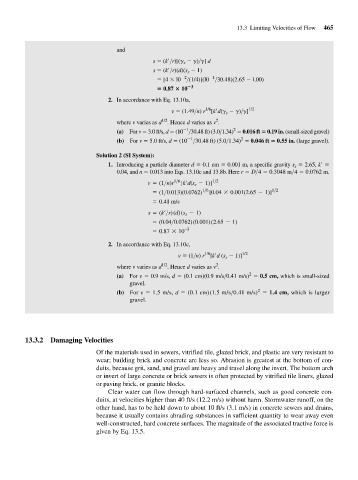Page 507 - Fair, Geyer, and Okun's Water and wastewater engineering : water supply and wastewater removal
P. 507
JWCL344_ch13_457-499.qxd 8/7/10 8:49 PM Page 465
13.3 Limiting Velocities of Flow 465
and
s (k >r)[(g s g)>g] d
s (k >r)(d)(s s 1)
1
2
[4 l0 >(1/4)](l0 >30.48)(2.65 l.00)
0.87 10 3
2. In accordance with Eq. 13.10a,
1/6
v (1.49>n) r [k d(g s g)>g] 1/2
1/2
2
where v varies as d . Hence d varies as v .
1
2
(a) For v 3.0 ft/s, d (10 >30.48 ft) (3.0>1.34) 0.016 ft 0.19 in. (small-sized gravel)
1
2
(b) For v 5.0 ft/s, d (10 >30.48 ft) (5.0>1.34) 0.046 ft 0.55 in. (large gravel).
Solution 2 (SI System):
1. Introducing a particle diameter d 0.1 cm 0.001 m, a specific gravity s s 2.65, k
0.04, and n 0.013 into Eqs. 13.10c and 13.8b. Here r = D>4 = 0.3048 m>4 = 0.0762 m.
v = (1>n)r 1>6 [k¿d(s s - 1)] 1>2
= (1>0.013)(0.0762) 1>6 [0.04 * 0.001(2.65 - 1)] 1>2
= 0.41 m/s
s = (k¿>r) (d) (s s - 1)
= (0.04>0.0762) (0.001) (2.65 - 1)
= 0.87 * 10 -3
2. In accordance with Eq. 13.10c,
1/6
v (1>n) r [k d (s s 1)] 1/2
1/2
2
where v varies as d . Hence d varies as v .
2
(a) For v 0.9 m/s, d (0.1 cm)(0.9 m/s>0.41 m/s) 0.5 cm, which is small-sized
gravel.
2
(b) For v 1.5 m/s, d (0.1 cm)(1.5 m/s>0.41 m/s) 1.4 cm, which is larger
gravel.
13.3.2 Damaging Velocities
Of the materials used in sewers, vitrified tile, glazed brick, and plastic are very resistant to
wear; building brick and concrete are less so. Abrasion is greatest at the bottom of con-
duits, because grit, sand, and gravel are heavy and travel along the invert. The bottom arch
or invert of large concrete or brick sewers is often protected by vitrified tile liners, glazed
or paving brick, or granite blocks.
Clear water can flow through hard-surfaced channels, such as good concrete con-
duits, at velocities higher than 40 ft/s (12.2 m/s) without harm. Stormwater runoff, on the
other hand, has to be held down to about 10 ft/s (3.1 m/s) in concrete sewers and drains,
because it usually contains abrading substances in sufficient quantity to wear away even
well-constructed, hard concrete surfaces. The magnitude of the associated tractive force is
given by Eq. 13.5.

